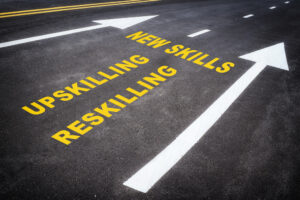
By focusing on upskilling existing talent, businesses can harness the full potential of AI, ensuring employees are ready to meet the challenges and opportunities of tomorrow.
Incorporating AI into your workplace transformation strategy has become a necessity. Today, 73% of businesses have already begun applying AI to specific departments and business challenges. However, the key to leveraging AI effectively lies in upskilling existing talent to keep up with the rapid pace of innovation.
The conversation around automation in the workplace often generates fear, with 65% of IT workers saying that AI made them concerned for their jobs, according to our most recent State of Data Science survey. But when leaders implement AI properly, it can make every employee productive and unlock new professional opportunities. By focusing on upskilling, organizations can ensure that their workforce remains relevant and competitive in an AI-driven market.
AI Leadership is Essential for Upskilling
The rise in AI-focused titles is a signal of how quickly businesses are shifting to embrace AI. Roles like “Chief AI Officer” oversee how AI is harnessed internally, ensuring that it supports employee development rather than replacing jobs. These leaders are responsible for developing strategies that integrate AI into daily operations while promoting continuous learning and skill enhancement.
Business leaders should prioritize having someone oversee their use of AI. If a role like Chief AI Officer isn’t feasible, appointing an internal AI leader should be a top priority. This designated leader can develop guardrails for AI’s impact on the workforce and spearhead upskilling initiatives, ensuring that employees are equipped with the skills needed to leverage AI tools effectively.
When putting an AI leader in place, some key considerations include:
- Identifying the right fit: An AI leader should understand AI and track its rapid development. Often, the Chief Innovation Officer or Chief Technology Officer will be suitable for this role. These leaders should also possess strong communication skills to articulate the benefits and strategies of AI adoption across the organization.
- Inclusive decision making: Multiple voices, including business units, HR leaders, and legal/risk teams, should be involved to ensure AI policies align with overall business goals. This collaboration ensures that AI initiatives are comprehensive and address the needs of the entire organization while balancing diversity, equity, and inclusion.
- Evaluating AI’s impact: The AI leader and teams should assess current and future AI investments, identifying areas where AI can transform roles and operations. This opens discussions on how automation can lighten workloads and allow existing roles to evolve. Regular assessments help in measuring the effectiveness of AI initiatives and making necessary adjustments.
With the right AI leadership, businesses can not only navigate the complexities of AI integration but also unlock the potential for continuous employee growth and innovation. This strategic approach ensures that AI serves as a tool for empowerment and advancement within the organization.
See also: Modernization Plans Dependent on Overcoming Skills Shortages
AI Upskilling for Both Technical and Non-Technical Employees
With an AI leader in place, businesses can begin their upskilling efforts and help their employees take on more impactful roles and responsibilities. While AI is being used extensively among developers to help with their code, even non-technical employees can benefit from AI upskilling. Here are a few ways AI can be employed to support skills development:
- Personalized learning and growth: AI can provide tailored pathways for early career professionals to hone their skills and set personal goals. For example, AI-driven learning platforms can recommend courses, certifications, and projects based on individual strengths and career aspirations. For established employees, AI can help identify new areas for professional growth, leading to greater confidence and team impact.
- Focus on meaningful work: AI can automate routine tasks, enabling both technical and non-technical employees to focus on enriching projects. For instance, AI can handle data entry, report generation, and basic customer inquiries, freeing up employees to engage in strategic planning, creative problem-solving, and customer relationship management. This shift prepares them for advanced roles sooner.
- Real-time collaboration: AI enhances real-time collaboration, making it easier for teams to connect and share knowledge. AI-powered collaboration tools can facilitate virtual meetings, real-time document editing, and project management, allowing teams to work together seamlessly, regardless of their physical locations. This dynamic interaction accelerates skill development and project success.
Notice how none of these outcomes necessarily translates to a hard skill like becoming an expert Python developer (though you can do that, too). In fact, soft skills like collaboration, people management, and creative thinking are all expected to become even more important for an AI-powered workforce. These skills ensure that employees can adapt to new technologies and workflows, fostering a resilient and innovative organizational culture.
Start Building an AI-powered Workforce
The future of work is not about AI replacing jobs but enhancing them. Business leaders that use AI to empower employees will drive better performance, innovation, and competitive edge. The most important action is to start building a foundation for a human-centered AI-powered workforce today.
By focusing on upskilling existing talent, businesses can harness the full potential of AI, ensuring employees are ready to meet the challenges and opportunities of tomorrow. This approach not only supports employee development but also strengthens the organization’s capacity for innovation and growth. Investing in AI-driven upskilling initiatives today prepares the workforce for a future where technology and human ingenuity go hand in hand, driving sustained success and competitiveness.





























